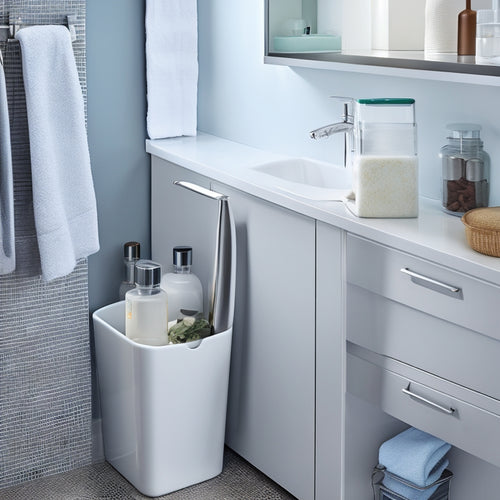
Revolutionizing Farm Efficiency: UVM Ag Engineering Showcase
Share
The University of Vermont's Agricultural Engineering Showcase is a pioneering facility that has revolutionized farm efficiency by incorporating sustainable design, optimizing workflows, and leveraging advanced technologies to streamline post-harvest operations. The facility's design prioritizes comfort, cleanliness, and visual appeal, featuring sustainable materials, efficient systems, and carefully planned equipment layouts to minimize congestion. By segregating harvested and washed produce, the facility guarantees consistent product quality, increased capacity, and high food safety standards. With a focus on resource sharing and education, the showcase promotes knowledge exchange and best practices among farmers. Explore the showcase's innovative solutions and transformation journey to discover more.
Key Takeaways
• The UVM Ag Engineering Showcase features a green building design with sustainable materials and efficient systems to minimize environmental impact.
• The facility's layout is carefully planned to optimize workflow, reduce congestion, and maintain high food safety standards.
• The renovation project invested approximately $250,000, with grant funds covering a significant portion of the expenses.
• The showcase aims to share knowledge and experience with the agricultural community through post-harvest education and community networking.
• The project's strategic design and resource allocation resulted in a well-designed facility that improves operational efficiency and increases capacity.
Facility Design and Features
The University of Vermont's Agricultural Engineering Showcase features a thoughtfully designed facility that prioritizes comfort, cleanliness, and visual appeal through a phased building approach. This green building incorporates sustainable materials and efficient systems to minimize environmental impact.
The equipment layout is carefully planned to optimize workflow, reduce congestion, and guarantee easy access to essential components. The packshed area is particularly remarkable, featuring in-floor trench drains, an upgraded greens spinner, and a hand-washing station to maintain high sanitation standards.
The use of repurposed materials and natural lighting further enhances the facility's aesthetic appeal. Overall, the showcase demonstrates a commitment to creating a safe, efficient, and environmentally responsible agricultural engineering facility.
Streamlining Operational Efficiency
By optimizing product flow and segregating harvested and washed produce, the facility achieves efficient movement and reduces bottlenecks, guaranteeing a smooth shift from field to delivery. This streamlined approach enables improving workflow and enhancing productivity, ultimately resulting in consistent product quality and increased capacity.
The separate flow for harvested and washed produce ensures a clean and safe environment, meeting the highest standards of food safety. Efficient loading and unloading through double doors further facilitate the process, making it easier to shift from harvest to delivery.
Cost and Funding Breakdown
Approximately $250,000 was invested in the renovation project, with a breakdown of costs including farm labor, grant funds, materials, and major expenses like electrical service, water trenching, insulation, and contractor labor.
The grant allocation played a significant role in completing the project, covering a substantial portion of the renovation expenses. This funding enabled the implementation of critical features, such as the upgraded wash-pack area and coolers, ensuring a safe and efficient working environment.
The careful planning and allocation of resources resulted in a well-designed facility that meets the needs of the farm, improving operational efficiency and reducing stress from debt.
Resource Sharing and Education
In addition to the successful implementation of the UVM Ag Engineering Showcase, the project's organizers are committed to sharing their experience and knowledge with the agricultural community, recognizing the value of collaborative learning and resource sharing in advancing post-harvest operations.
Through post-harvest education and community networking, the project aims to facilitate knowledge exchange and best practices among farmers, promoting a culture of continuous improvement. The showcase's online resources, including case studies, building features, and equipment information, provide a valuable platform for farmers to learn from each other and adapt innovative solutions to their own operations.
Behind the Scenes Stories
Patrick Sullivan, the farmer behind the UVM Ag Engineering Showcase, shares the less-than-glamorous aspects of the project, including the unexpected challenges and unforeseen consequences that arose during the renovation process. One of the significant project challenges was the simultaneous floor work and wall finishing, which proved to be more complicated than anticipated.
Sullivan also regrets not having a central packshed location, as it would have improved the overall workflow. Despite these setbacks, the farm transformations have yielded significant benefits, including increased capacity, labor benefits, and consistent product quality.
These behind-the-scenes stories provide valuable insights into the realities of farm transformations, highlighting the importance of meticulous planning and adaptability in overcoming project challenges.
Project Acknowledgments and Thanks
The successful completion of the UVM Ag Engineering Showcase renovation project would not have been possible without the dedication and hard work of various individuals and organizations.
| Individuals | Organizations | Role |
|---|---|---|
| Patrick Sullivan | UVM Ag Engineering | Project Lead |
| Melisa Oliva | Vermont Agency of Agriculture | Funding Support |
| USDA | Grant Funding | |
| FDA | Regulatory Guidance | |
| Postharvest Planning Guide | Resource Provider |
We extend our gratitude to these individuals and organizations for their valuable contributions. Their acknowledgment is a reflection of the project's success, and we appreciate their efforts in taking on and completing this ambitious undertaking.
Farm Efficiency Takeaways
Optimized facility design and operational efficiency strategies have emerged as key takeaways from the UVM Ag Engineering Showcase renovation project. These key insights provide valuable implementation strategies for farmers seeking to enhance their operations.
-
Phased building approach to create a comfortable and efficient workspace
-
Emphasis on well-designed wash-pack areas and multi-zone storage for improved product quality
-
Efficient product flow and loading/unloading processes to reduce bottlenecks
-
Importance of daily cleaning routines for food safety and efficient operations
-
Availability of resources, such as post-harvest planning guides, to aid in project planning and cost management
Frequently Asked Questions
How Does the Packshed's Design Impact Employee Morale and Job Satisfaction?
Like a breeze of new energy, the packshed's well-designed workspace invigorates employee morale and job satisfaction, fostering a positive workplace culture where employee wellness thrives, thanks to improved lighting, efficient product flow, and reduced bottlenecks.
Are There Any Plans for Future Expansions or Upgrades to the Facility?
Future plans involve capacity optimization through strategic partnerships, exploring opportunities for vertical integration and technology upgrades to enhance efficiency, while maintaining a focus on employee safety and satisfaction.
What Role Does Technology Play in the Packshed's Operational Efficiency?
At the heart of the packshed's operational efficiency lies a symphony of technology, where automation tools orchestrate streamlined processes and data analytics harmonize production, ensuring precision, accuracy, and a safer food supply chain.
How Does the Facility's Design Address Environmental Sustainability Concerns?
The facility's design incorporates eco-friendly features, such as green roofing for insulation and stormwater management, and natural lighting through strategically placed windows and skylights, reducing energy consumption and promoting a sustainable work environment.
Are There Any Metrics in Place to Measure the Packshed's Long-Term Success?
Just as a finely-tuned orchestra requires precise metrics to harmonize performance, the packshed's long-term success is measured by cost savings and key performance indicators, such as reduced energy consumption, increased productivity, and enhanced food safety standards.
Related Posts
-

Stockpile Essentials: Must-Have Items for Home
I keep my home stocked with essentials to avoid last-minute trips and guarantee smooth daily operations. I prioritize...
-

Corner Kitchen Storage Solutions to Boost Efficiency
To boost efficiency in your kitchen, you'll want to strategically utilize corner storage solutions. Start by measurin...
-

Revamp Your Under-Sink Setup Like a Pro
To revamp your under-sink setup like a pro, start by evaluating your space and categorizing existing items, taking no...


